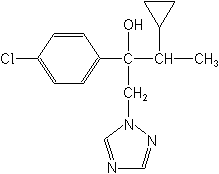-
Common NameCyproconazole
-
中文通用名环丙唑醇
-
IUPAC(2RS,3RS;2RS,3SR)-2-(4-chlorophenyl)-3-cyclopropyl-1-(1H-1,2,4-triazol-1-yl)butan-2-ol
-
CASα-(4-chlorophenyl)-α-(1-cyclopropylethyl)-1H-1,2,4-triazole-1-ethanol
-
CAS No.94361-06-5
-
Molecular FormulaC15H18ClN3O
-
Molecular Structure
-
Category
-
ActivityFungicide
-
PremixTrifloxystrobin+cyproconazole
Cyproconazole+picoxystrobin
Chlorothalonil+cyproconazole+propiconazole
Chlorothalonil+cyproconazole
Azoxystrobin+cyproconazole
Emulsifiable concentrate, flowable suspension, soluble liquid, wettable granule. Premix Parters: gibberellic acid indole-3-butyric acid; indole-3-butyric acid; indole-3-butyric acid 1-naphthaleneacetic acid.
-
Physical PropertiesMolecular weight:291.8; Physical form:Colourless solid. Density:1.259 g/cm3; Composition:It is a mixture (c. 1:1) of 2 diastereoisomers. Melting point:106-109 °C; Flash point:No reaction up to 360 °C; Vapour pressure:3.46×10-2 mPa (20 °C); Partition coefficient(n-octanol and water):logP = 2.91 ( pH 7); pKa:No acid or base properties in range pH 3.5-10.; Solubility:In water 140 mg/l (25 °C). In acetone 230, ethanol 230, dimethyl sulfoxide 180, xylene 120 (all in g/l, 25 °C). Stability:Decomposition is <5% after storage for 2 years. Stable in aqueous solutions at pH 1-9 for a test period of 35 days (50 °C) or 14 days (80 °C). Slowly hydrolysed in 1N HCl and NaOH. Stable upon storage and in water. Solubility in acetone 230 g/l, ethanol, 230 g/l, dimethyl sulfoxide 180 g/l, xylene 120 g/l.
-
ToxicologyOral:Acute oral
LD50 for male rats 1020 mg/kg, female rats 1333 mg/kg, male mice 200 mg/kg, female mice 218 mg/kg. Percutaneous:Acute percutaneous LD50 for rats and rabbits >2000 mg/kg. Non-irritating to skin and eyes (rabbits). Non-irritating to skin, and not a skin sensitiser (guinea pigs). Inhalation: LC50 (4 h) for rats >5.65 mg/l air. -
Environmental ProfileEcotoxicology:
Bees:LD50 (contact) >0.1 mg/bee; (oral) >1 mg/bee.Birds:Acute oral LD50 for Japanese quail 150 mg/kg. Dietary LC50 (8 d) for Japanese quail 816, mallard ducks 1197 mg/kg diet.Daphnia: LC50 (48 h) 26 mg/l.Fish: LC50 (96 h) for carp 18.9, trout 19, bluegill sunfish 21 mg/l.
Environmental fate:
Animals:In mammals, following oral administration, cyproconazole is rapidly absorbed, extensively metabolised and excreted,DT50 c. 30 h. No bioaccumulation.Soil:In soil, cyproconazole degrades moderately quickly, DT50 c. 3 mo. No accumulation and leaching potential. Soil adsorption, Freundlich K 4.1 (loam, pH 6.4, o.m. 2.3%), 16 (loamy sand,
WATER SOLUBILITY: 140 mg/l at 22°C -
Transport InformationSignal Word:CAUTION; Hazard Class:II (Moderately hazardous)
Porduct NewsMore
UPL launched multisite fungicide Tridium in Argentina
Azoxystrobin Mancozeb Cyproconazole
ECHA adopted opinions on CLHs for three pesticides
Spiroxamine Cyproconazole momfluorothrin
Related CompaniesMore
Jiangsu Sword Agrochemicals Co., Ltd.
Country: China
Triadimefon Triadimenol Tebuconazole Diniconazole Bitertanol Cyproconazole Propineb Paclobutrazol Metribuzin Bentazone
Yancheng Limin Chemical Co.,Ltd
Country: China
Triadimefon Triadimenol Hexaconazole Flutriafol Imidacloprid Paclobutrazol Tebuconazole Thifluzamide Indoxacarb Uniconazole
Shanghai Heben-Eastsun Medicaments Co., Ltd.
Country: China
Thiamethoxam Azoxystrobin Boscalid Chlorfenapyr Difenoconazole Fludioxonil Indoxacarb Picoxystrobin Pyraclostrobin Tebuconazole
Jiangsu Sevencontinent Green Chemical Co., Ltd.
Country: China
Tebuconazole Flutriafol Epoxiconazole Propiconazole Difenoconazole Pyraclostrobin Glufosinate-ammonium Metribuzin Cyproconazole Clethodim
Rudong Zhongyi Chemical Co., Ltd.
Country: China
Pyraclostrobin Trifloxystrobin Prothioconazole tebuconazole pyriproxyfen cyproconazole cyazofamid famoxadone

 0
0 Subscribe
Subscribe
